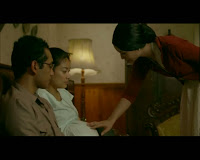Director: Greg Lamberson
Release date: 1991
Contains spoilers
Undying Love, or New York Vampire, had a lot of things against its favour… it really did. Low budget, poor scripting and amateurish acting and yet it raised above all that to become something, if not brilliant, certainly watchable.
Part of this was to do with the film quality. It looked as though it had emerged from the 70s rather than being filmed in the 90s and it carried a gritty aspect because of this.
 |
| opening suicide |
That grittiness was apparent in the opening shot. It is a window, back lit, that proves to be in a door. It opens and Scott (Tommy Sweeney) comes into view. He switches on the light and we see it is a bathroom. The music fleshes the atmosphere as we see, in cuts, him get into the bath and then slit his wrists. It was a visceral opening scene.
New York, and the music changes to hip hop. A couple are in a drugs den and there is a knock on the door. A well-dressed man, Evan (Andrew Lee Barrett), comes into the room and they check him for weapons. He takes a seat in front of the man, as the woman holds a gun on him. He passes the briefcase over, but when opened it is empty. Evan tells the man he wants his money. He snaps the man’s neck and then knocks the woman out before taking their cash. Before he leaves he picks her wrist up and bites.
 |
| Julie Lynch as Carmilla |
Curtis (Terry Spivey) is throwing a party and Scott arrives. He is offered a wine cooler but he wants a beer. Two negatives come into play here. One is Sweeney as lead, he isn’t massively dynamic and he comes across as a bit wooden. However, that actually works as the film progresses because he seems stoic – only failing, really, when he does a quick take later in the film and stoic melts into caricature. The other failing is in the dialogue, he is there without Lesley (Mary Huner), his girlfriend, but everyone refers to him as Lesley’s boyfriend who tried to kill himself – to his face – it just wouldn’t happen. The exception to this is when Carmilla (Julie Lynch) approaches him, she talks about death as though it were a positive and, of course, given her name we know what she is.
 |
| Carmilla and Evan |
She is a model, she says, and she is quickly dragged away from him by Renny (Robert C Sabin), her photographer friend. Scott goes back to Lesley’s place and has sex but it is clear, through the cuts, that he is thinking of Carmilla and there is a religious aspect here as Lesley has plenty of catholic paraphernalia that the camera also focuses on, as well as cuts back to the suicide. What I liked, though whether the filmmakers did it purposefully or not is up for grabs, was the way that he was attracted to Carmilla and she to him and he was an attempted suicide. It tied in neatly with the tradition of suicides becoming vampires – for we already know what will happen to him.
 |
| Scott transitioning |
Wint (Lee Kayman) is a cop. One of his cop buddies pulls him in to tell him about the drugland murders – and the fact that the girl was totally drained of blood. His buddy then goes on to say that Wint shouldn’t obsess as he only has 7 months until retirement and no one wants to hear his stories of vampires. The question then is why bloomin’ tell him in the first place? It seems that his partner was killed by vampires 25 years before (by Evan and Carmilla). Meanwhile Scott finds Carmilla, they go out and then back to his place. She goes down on him, a comment is made about teeth and when she is finished he is dead – she tells the corpse that things are only going to get better.
 |
| Lesley's fate |
So, of course, he is a fledgling vampire and we get some of the standard stuff, such as raw meat eating and inability to eat cooked food etc. The moment of his awakening, going to the toilet, crying out in pain and a toilet bowl red with blood offered a glimpse of an std undertone. Things start coming together – Carmilla kills Renny by ripping his balls off, chewing out his tongue and drinking his blood, but his pictures of Carmilla alert Wint to the right trail. Evan, it seems, is jealous and barely puts up with Carmilla’s playthings. He turned her during the French revolution, and his jealousy sends him towards Lesley (who catches Scott in bed with Carmilla anyway).
 |
| play acting |
There are deeper motives playing out in the background but I won’t spoil them. However the way the vampires are done is interesting. Wint has clearly researched vampires. When he confronts Evan he puts garlic and crucifixes up, he carries a cross and has holy water. This all seems to work as he chases Evan around with the cross and then corners him, trapping him with holy water. That is until Evan reveals that he was play acting, none of those things affect vampires.
 |
| staked |
We do get a staking, but it is of Wint with his own cross, and Evan reveals that vampires can die by ordinary means – though it is apparent that they can take more damage than a normal human. Evan has a tendency to tape razor blades to his fingers and use those as a weapon, but beyond that we don’t get anything like fangs and claws (Carmilla has sharp nails, but there is nothing supernatural about them). They do seem physically stronger than humans.
 |
| blooded |
The problem with the film was exactly as I highlighted at the head of the review. The budget was low, the script wasn’t always logical (telling Wint about a murder then warning him off) and the dialogue senseless in places (discussing Scott’s suicide attempt in front of Scott). The vampire characters weren’t fleshed out as well as I would have liked. Julie Lynch was fun, but most of the cast weren’t brilliant actors.
Yet the film had ideas I liked, and an atmosphere (that may well have been accidental) that worked. The ending is dour and I liked that also.
4 out of 10.
The imdb page is
here.
































































